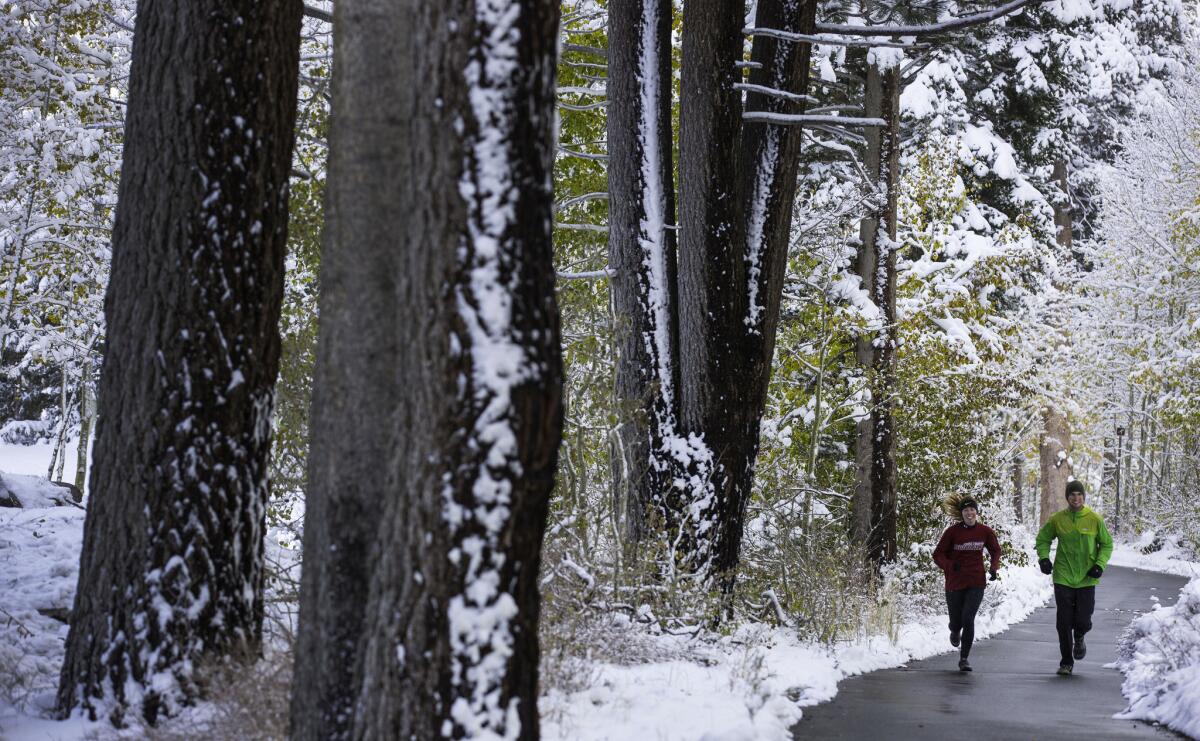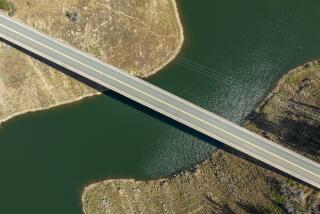Early-season storm makes small dent in California’s drought outlook

A couple run on a trail after a fall Sierra Nevada storm dropped nearly a foot of snow at Mammoth Mountain and less in town in Mammoth Lakes.
- Share via
An early-season storm that blanketed mountains from Northern California to the Central Valley with snow showed tangible results on the state’s historic drought, new federal data show.
Two areas of California considered to be in “exceptional” drought were upgraded to the “extreme” category — the best either area has seen since at least the beginning of summer, according to the U.S. Drought Monitor.
A third area also was upgraded from extreme to severe, an even better improvement.
On Monday, a Pacific storm dumped between 11 and 30 inches of snow on mountains from Truckee to Mammoth. The new data show that a portion of Modoc County moved from exceptional drought to extreme.
That area had been in exceptional drought since early July. Farther south, in Mono and Inyo counties, two swaths of land that had been in exceptional drought since January and February were finally upgraded. One area bordering Nevada also moved into the severe category.
The U.S. Drought Monitor report, which comes out weekly and provides a glimpse of the nation’s drought status by region, called the rain and snow an “early bonus” for California’s water year, which runs from Oct. 1 to Sept. 30.
“But with 4 consecutive years of drought, this precipitation was just a start to moisten the soils for hopefully more (frozen preferred) precipitation this winter,” the report stated.
The past six months have been unusually wet in the eastern part of the state, the report said, also laying the groundwork for more gains on the state’s drought if there’s a large El Niño rain season as many experts predict.
“This past 6 months of wetness in a semi-arid environment is significant and a good start to … the water year,” it said.
Water and Power is The Times’ guide to the drought. Sign up to get the free newsletter >>
There needs to be more snow in the Sierra Nevada, however, for experts to upgrade those areas. Much of the mountain range remains in the worst category. Less than two-tenths of a percent of California is not under some level of drought.
Snowpack is a key factor in California’s water supply: In a normal year, melting Sierra Nevada snow provides the state with one-third of its water. Another third is pumped from aquifers, and the rest comes from rivers and reservoirs.
This spring, researchers found that the amount of water contained in the snow on April 1 was 5% of the average snow-water equivalent since monitoring began.
A new federal forecast released in October showed the upcoming El Niño could bring rains into Northern California, reaching more vital reservoirs than previously predicted. El Niño is a weather phenomenon that involves warming sea-surface temperatures and a change in wind that alters weather patterns in the atmosphere worldwide.
For breaking California news, follow @JosephSerna.
ALSO
Classes resume at UC Merced campus after stabbing rampage
KKK lynching message on Berkeley High School computer traced to student
Hundreds launch hunger strike at immigrant detention center in Adelanto, Calif.
More to Read
Sign up for Essential California
The most important California stories and recommendations in your inbox every morning.
You may occasionally receive promotional content from the Los Angeles Times.









